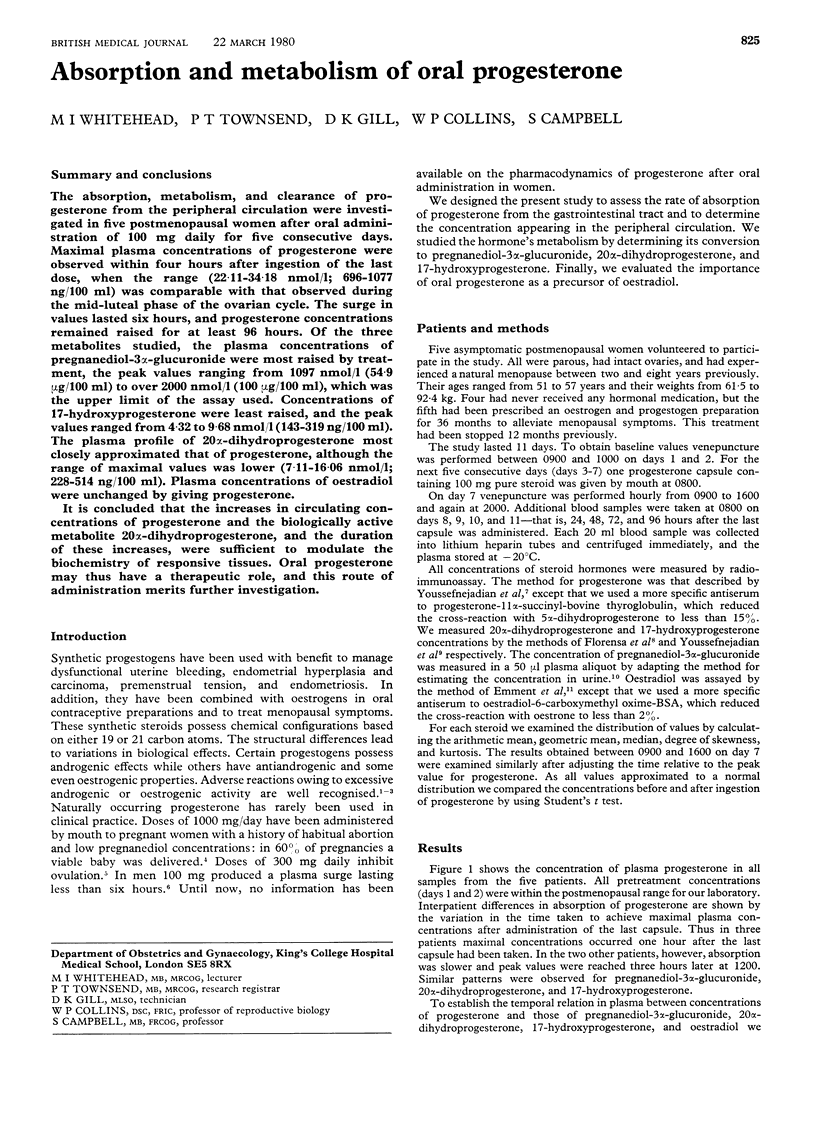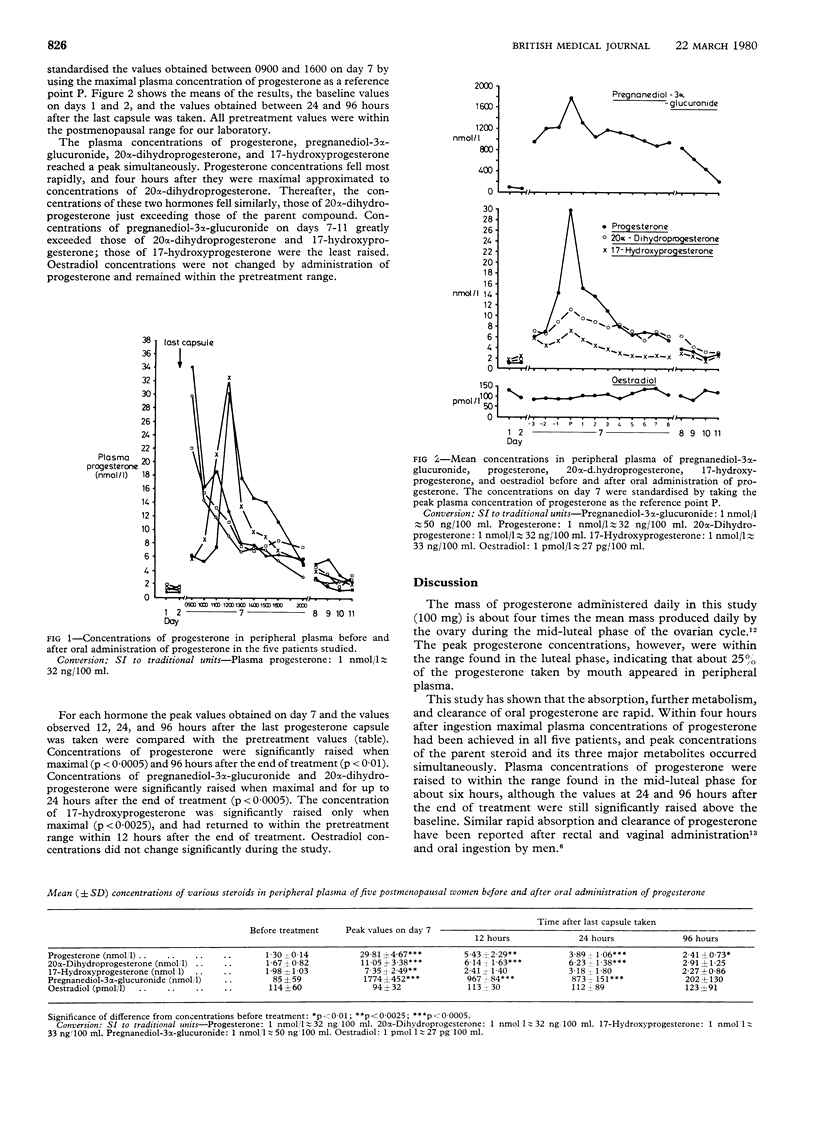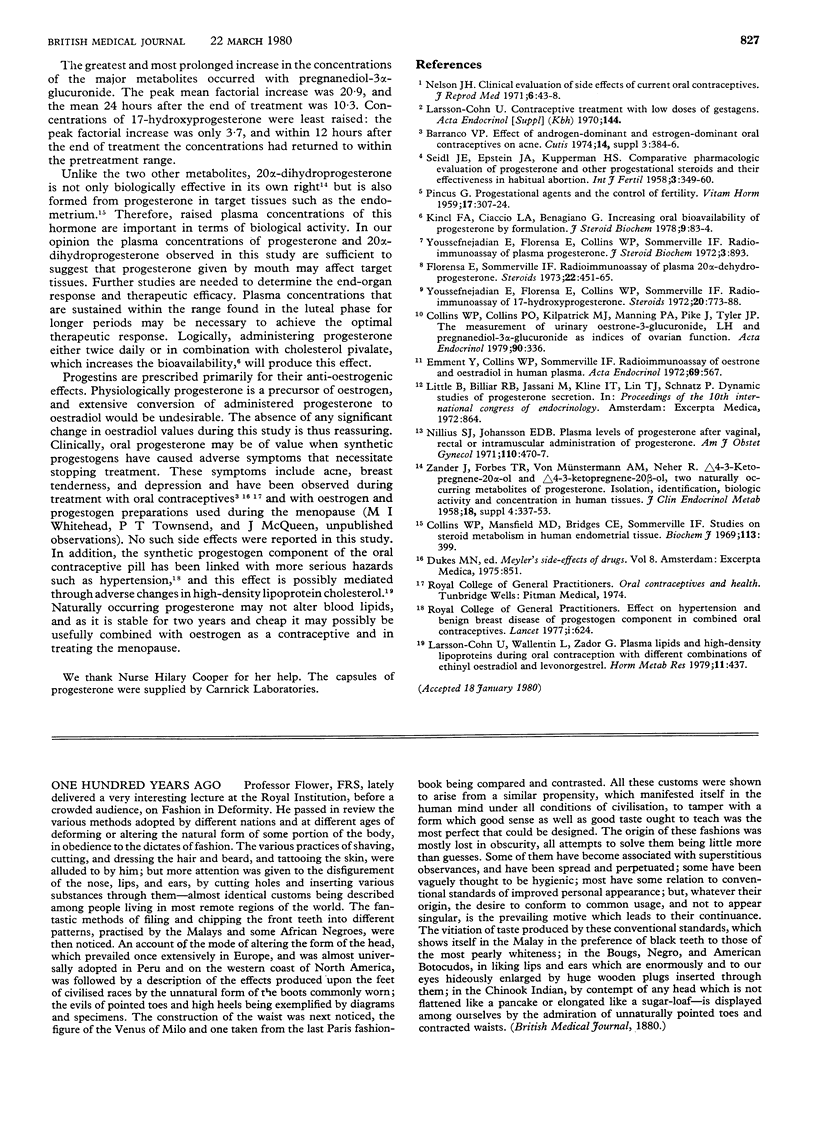Abstract
The absorption, metabolism, and clearance of progesterone from the peripheral circulation were investigated in five postmenopausal women after oral administration of 100 mg daily for five consecutive days. Maximal plasma concentrations of progesterone were observed within four hours after ingestion of the last dose, when the range (22.11-34.18 nmol/l; 696-1077 ng/100 ml) was comparable with that observed during the mid-luteal phase of the ovarian cycle. The surge in values lasted six hours, and progesterone concentrations remained raised for at least 96 hours. Of the three metabolites studied, the plasma concentrations of pregnanediol-3 alpha-glucuronide were most raised by treatment, the peak values ranging from 1097 nmol/l (54.9 microgram/100 ml) to over 2000 nmol/l (100 microgram/100 ml), which was the upper limit of the assay used. Concentrations of 17-hydroxyprogesterone were least raised, and the peak values ranged from 4.32 to 9.68 nmol/l (143-319 ng/100 ml). The plasma profile of 20 alpha-dihydroprogesterone most closely approximated that of progesterone, although the range of maximal values was lower (7.11-16.06 nmol/l; 228-514 ng/100 ml). Plasma concentrations of oestradiol were unchanged by giving progesterone. It is concluded that the increases in circulating concentrations of progesterone and the biologically active metabolite 20 alpha-dihydroprogesterone, and the duration of these increases, were sufficient to modulate the biochemistry of responsive tissues. Oral progesterone may thus have a therapeutic role, and this route of administration merits further investigation.
Full text
PDF


Selected References
These references are in PubMed. This may not be the complete list of references from this article.
- Collins W. P., Collins P. O., Kilpatrick M. J., Manning P. A., Pike J. M., Tyler J. P. The concentrations of urinary oestrone-3-glucuronide, LH and pregnanediol-3alpha-glucuronide as indices of ovarian function. Acta Endocrinol (Copenh) 1979 Feb;90(2):336–348. doi: 10.1530/acta.0.0900336. [DOI] [PubMed] [Google Scholar]
- Collins W. P., Mansfield M. D., Bridges C. E., Sommerville I. F. Studies on steroid metabolism in human endometrial tissue. Biochem J. 1969 Jun;113(2):399–407. doi: 10.1042/bj1130399. [DOI] [PMC free article] [PubMed] [Google Scholar]
- Emment Y., Collins W. P. Radioimmunoassay of oestrone and oestradiol in human plasma. Acta Endocrinol (Copenh) 1972 Mar;69(3):567–582. doi: 10.1530/acta.0.0690567. [DOI] [PubMed] [Google Scholar]
- Florensa E., Sommerville I. F. Radioimmunoassay of plasma 20 alpha-dihydroprogesterone. Steroids. 1973 Oct;22(4):451–465. doi: 10.1016/0039-128x(73)90001-9. [DOI] [PubMed] [Google Scholar]
- Larsson-Cohn U. Contraceptive treatment with low doses of gestagens. Acta Endocrinol Suppl (Copenh) 1970;144(Suppl):1+–1+. doi: 10.1530/acta.0.064s007. [DOI] [PubMed] [Google Scholar]
- Larsson-Cohn U., Wallentin L., Zador G. Plasma lipids and high density lipoproteins during oral contraception with different combinations of ethinyl estradiol and levonorgestrel. Horm Metab Res. 1979 Jul;11(7):437–440. doi: 10.1055/s-0028-1092755. [DOI] [PubMed] [Google Scholar]
- Nillius S. J., Johansson E. D. Plasma levels of progesterone after vaginal, rectal, or intramuscular administration of progesterone. Am J Obstet Gynecol. 1971 Jun 15;110(4):470–477. [PubMed] [Google Scholar]
- Youssefnejadian E., Florensa E., Collins W. P., Sommerville I. F. Radioimmunoassay of 17-hydroxyprogesterone. Steroids. 1972 Dec;20(6):773–788. doi: 10.1016/0039-128x(72)90057-8. [DOI] [PubMed] [Google Scholar]
- ZANDER J., FORBES T. R., VON MUNSTERMANN A. M., NEHER R. Delta 4-3-Ketopregnene-20 alpha-ol and delta 4-3-ketopregnene-20 beta-ol, two naturally occurring metabolites of progesterone; isolation, identification, biologic activity and concentration in human tissues. J Clin Endocrinol Metab. 1958 Apr;18(4):337–353. doi: 10.1210/jcem-18-4-337. [DOI] [PubMed] [Google Scholar]


